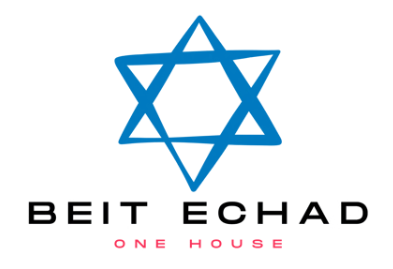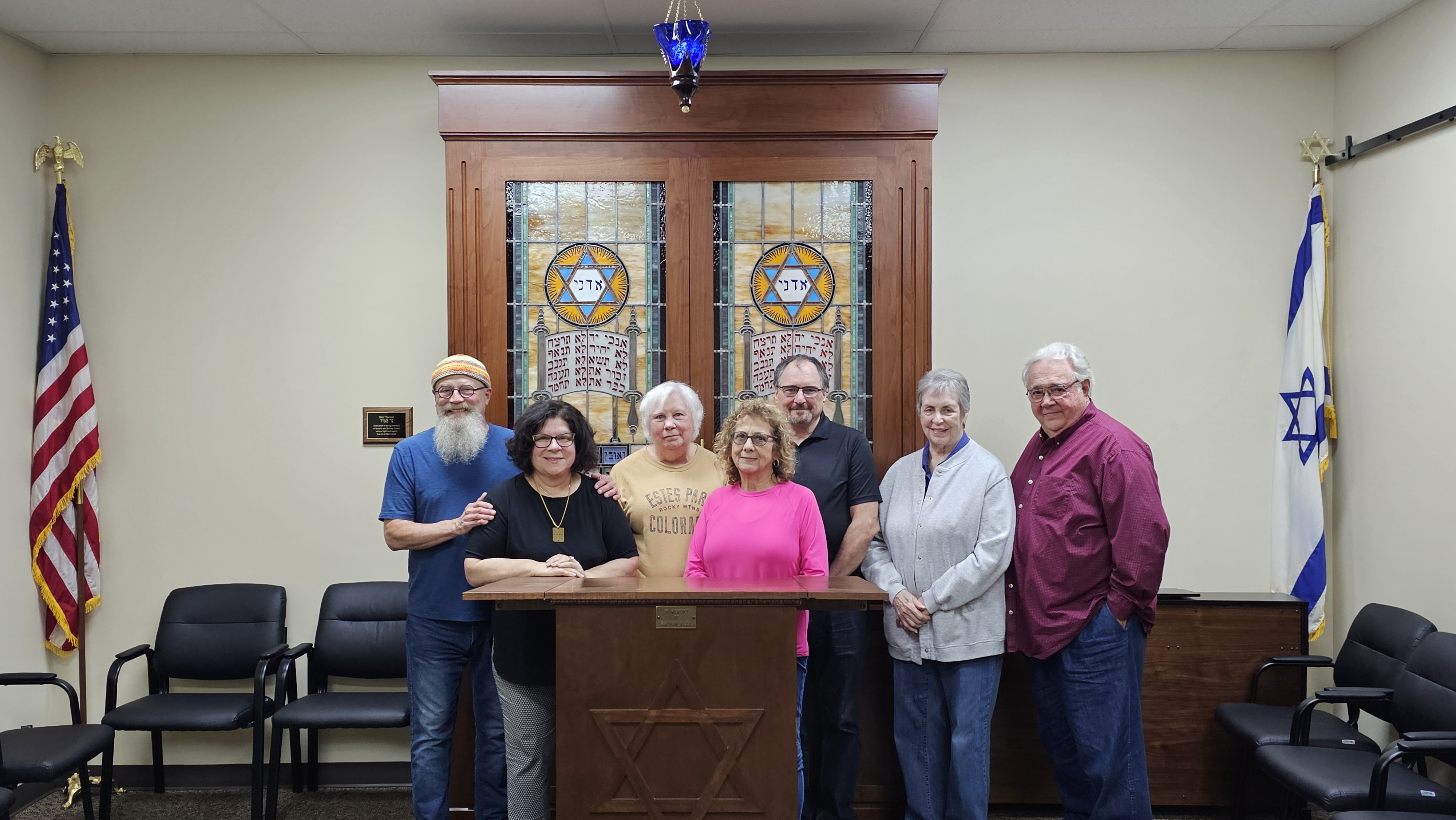Editor’s note: This is the second of a two-part series about Beit Echad, a new congregation in St. Joseph, Missouri. Read the first part here.
Beit Echad recently opened as the first new synagogue in St. Joseph, Missouri, in more than a century. Two synagogues, Temple Adath Joseph and Temple B’nai Sholem, have been the stewards of the community’s legacy and Jewish observances for decades. Now, the two congregations have worked together to form a new synagogue, Beit Echad, where all prayers and Jewish life will take place.
Adath Joseph and B’nai Sholem still exist as entities that support Beit Echad. B’nai Sholem sold its building in 2018, and though Adath Joseph still has its historic building, it is not in active use anymore. Both congregations still have boards and funds which contributed significantly to Beit Echad’s creation.
A new location
Beit Echad is located at 2247 N. Belt Hwy. in St. Joseph at the end of a strip mall. The synagogue has no windows other than its glass front door and inner vestibule door. Although this type of location is unconventional for a synagogue (especially in the Midwest), Beit Echad leaders say that the location is good for the congregation’s needs and has few downsides.
“Because there’s no glass frontage, it doesn’t feel like you’re walking into a retail store,” said Bob Ott, community member and president of B’nai Sholem. “Plus, for security reasons, it restricts visibility of what’s going on in here, so you don’t feel like you have to have curtains on the windows or worry about people peeking in at you. I think that this space just works tremendously well.”
Another benefit is that community member Steve Rosenak’s optometry office is in the same strip mall, meaning that there is a relationship and familiarity with the landlord and location.
Inside, the centerpiece of the sanctuary is its new ark. Neither Adath Joseph nor B’nai Sholem had an ark that would fit inside Beit Echad, so skilled community members and congregants worked to design and build a custom one. Stained glass from the old ark of B’nai Sholem was able to be repurposed for the Beit Echad one.
Unfortunately, the stained glass at Adath Joseph’s building is embedded into its walls and can’t be removed. However, the remaining glass from B’nai Sholem (which is currently in storage) is planned to be hung on the walls of the sanctuary in backlit shadow boxes.
Above the ark is a custom ner tamid (eternal light), dedicated in memory of community members Beverly and Sidney Cohen (z”l), that was handmade in Israel. Shipping issues because of the war in Israel delayed the arrival of the light until July, when it came without proper wiring. As with the ark, a community member stepped up and rewired the light to make it function properly.
Past the sanctuary are a small kitchen, social hall and restrooms. The location, while big enough for the congregation, is not big enough for the wealth of historical items from B’nai Sholem and Adath Joseph.
“It makes me sad that there’s not a lot coming over from either [synagogue]... we want history, because history is where we came from,” community member Sandy Rosenak said.
The yahrzeit plaques of B’nai Sholem and Adath Joseph are among the items that won’t fit. Each plaque is affixed to a large board and contains hundreds of names of deceased Jewish community members. Because of the importance of these items, the community devised a creative solution.
“We are going to take photos of the large yahrzeit plaques professionally, in a tasteful manner, and then create a memorial book that we’ll have [in the synagogue],” Steve Rosenak said. A committee might be formed in the future to return the plaques to the families of their loved ones.
Bringing new members and respecting history
Community members hope that the creation of Beit Echad will bring more congregants and attract any uninvolved Jews in St. Joseph.
“We want to draw new people… We want to reach out to people who normally didn’t feel they were a part of a Jewish community,” Steve Rosenak said. “We can attract new members from surrounding areas, because now, when they walk in, they’ll go, ‘Oh, it’s brand new. It’s not falling down. It’s in a safe neighborhood.’”
Current board member Sandy Smail of Maryville, Missouri, joined Adath Joseph after converting to Judaism a few years ago. She became invested in the future of the St. Joseph Jewish community, not least because the next nearest Jewish community to her was in Council Bluffs, Iowa, almost two hours away.
She was invited to join the board of Beit Echad, coming in with a fresh perspective and without the weight of Adath Joseph or B’nai Sholem’s long history. Smail said that it was easy to become a part of the community, and she feels as though she’s “come home, part of the family.”
“It’s exciting to be a part of something brand new,” Smail said. “I always likened it to giving birth — there’s a lot of hard work involved.”
While Beit Echad’s leadership looks forward to a new chapter, the closing of the old chapter isn’t easy.
“We still want to appreciate what we all bring to this. We want to appreciate who was here and who was in this community before us,” Ott said.
Dick Rosenthal, a lifetime St. Joseph resident, comes to Beit Echad with strong memories of the Jewish community when he was young, before synagogues Shaare Sholem and B’nai Yaakov merged into B’nai Sholem in 1960.
“Years ago, when there were three [synagogues], our family belonged to all three,” he said. “We used to go upstairs and sit with Bubbe, and downstairs was Zayde.”
The deep connection also extends to Sandy Rosenak, who remembers many of her life milestones at B’nai Sholem.
“I do think back, and I still feel the loss,” she said. “I feel the sadness. I miss it. We were married there… but we’ve grieved that loss.”
More work to do
The creation of Beit Echad — from religious, financial, legal and practical angles — was unprecedented in St. Joseph in the modern era. The synagogue is still looking at options for a regular part-time rabbi and potentially a Sunday school if more young Jewish families join in the future.
“It’s still in process,” Ott said about Beit Echad. “Yes, we finally got over this hurdle [opening the synagogue], but we still have blank walls. We still got Judaica to figure out what we’re going to do with. We’ve got to make a decision on a rabbi. We’ve got to determine what our costs are and how we’re going to cover them. All those things that every other synagogue that’s been in existence for decades and decades have already figured out.”
Despite the work ahead, Beit Echad is set to continue St. Joseph’s long Jewish history at a time when the Jewish people must remain strong.
“Especially given the terrible events of this past year in Israel and the frighteningly increasing antisemitism at home and around the world — not to mention the awful suffering of so many in the context of our war and the ongoing war in Ukraine — I was moved by the spirit of togetherness and deep desire by all involved with Beit Echad for connection — interpersonal, intrapersonal and with G-d,” said Rabbi Jonathan Rudnick, who led the congregation’s first High Holiday services.
The congregation has since been meeting every Friday night, and congregants continue their involvement and effort to maintain and grow the Beit Echad.
“The potential [for Beit Echad] is the exciting part,” Sandy Rosenak said. “We’ve got lots of ideas.”
More information about Beit Echad is available at beit-echad.net.




